
Promote wound healing: the best tips
A major goal of modern wound treatment is to optimally support the body's self-healing powers. This requires a deep understanding of the physiology of wound healing in order to be able to develop individual therapy strategies based on the latest scientific knowledge.
Phases of wound healing
Cleaning phase (exudation):
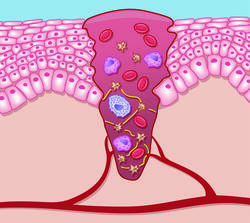
A blood clot forms immediately after the wound is formed. This is a kind of plug that closes the injured blood vessel and prevents further blood loss. In the case of superficial wounds, the cleaning phase takes about one day, and around four days for larger wounds. Here, so-called scavenger cells (phagocytes) migrate into the wound via blood vessels where they absorb and eliminate damaged cells and pathogens. This results in a natural cleaning of the wound.
Granulation phase:
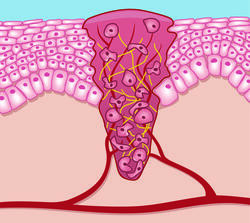
Between the third and seventh day after the injury, the body forms so-called replacement tissue (granulation tissue) to gradually close the wound. This creates new connective tissue and replaces damaged blood vessels.
Epithelialisation phase:
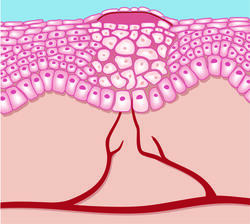
The duration of the epithelialisation phase depends on the size of the wound. Surface cells multiply and completely close the affected area. This is different with a deep wound that extends into the underlying dermis; in such a case, the body may need several months to regenerate such an area. Here, light-coloured scar tissue remains, which contains neither sebaceous nor sweat glands.
Regeneration phase:
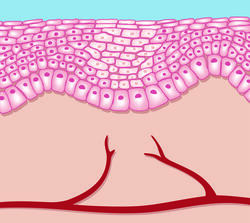
During the regeneration phase, the wound is completely closed. The newly created skin/scar is, however, still sensitive to environmental stimuli and requires special care to provide it with moisture and regenerative substances.
Antiseptic wound treatment
Bacterial infections are the main risk for complications in wound healing. Many antiseptics act by destroying or denaturing the cell wall of a pathogen and disturbing the pathogen’s metabolism resulting in cell death. Compared to antibiotics, antiseptics have the advantage that resistance occurs much less frequently, and may be even virtually non-existent for some antiseptics.
Modern antiseptics have a high therapeutic index and good tolerability, and, in contrast to antibiotics, are also suitable for preventive use in certain clinical indications. These measures can render prolonged treatment unnecessary in many cases. The indication for antisepsis depends on the stage, severity, location and degree of contamination/infection of the wound.
Requirements for modern wound antiseptics:
- Broad spectrum of activity
- Rapid onset of action
- No disturbance of wound healing
- Absorption as low as possible
- Effective even under high blood and protein stress
- Water-based
- Active ingredients in the lowest possible concentration
- Painless application
- No toxic/allergenic substances
- No development of resistance
- Colourless
- No contraindications in pregnancy/lactation/children
Recognized publications therefore recommend treatment of acutely infected wounds with octenidine or povidone-iodine. The first-line preparations for the treatment of chronic wounds include octenidine or polyhexanide.
Octenidine can therefore be used for any type of wound. The duo-active complex contained in octenisept® (octenidine and phenoxyethanol) is also faster than the individual substances (povidone-iodine, PHMB) and possesses a broad-spectrum of antimicrobial activity.
Efficacy of the active ingredients
Octenidine/phenoxyethanol
- Gram-positive: efficacy positive
- Gram-negative: efficacy positive
- Fungi: efficacy positive
- Spores: efficacy negative
- Viruses: efficacy positive
- Warning: not to be used in pockets, fistulas, etc.
Povidone iodine
- Gram-positive: efficacy positive
- Gram-negative: efficacy positive
- Fungi: efficacy positive
- Spores: efficacy positive
- Viruses: efficacy positive
- Warning: only for acute wounds, irritations, allergies, endocrine disorders
Polihexanide
- Gram-positive: efficacy positive
- Gram-negative: limited positive efficacy
- Fungi: efficacy positive
- Spores: efficacy negative
- Viruses: efficacy negative
- Warning: Long acting times, potentially carcinogenic
The right product for every phase of wound healing
Optimal wound healing requires absence of penetrating pathogens and “tranquil” healing conditions. A moist environment is also essential if the wound is to heal quickly without scarring, as cells responsible for closing the wound multiply and move particularly quickly under moist conditions.
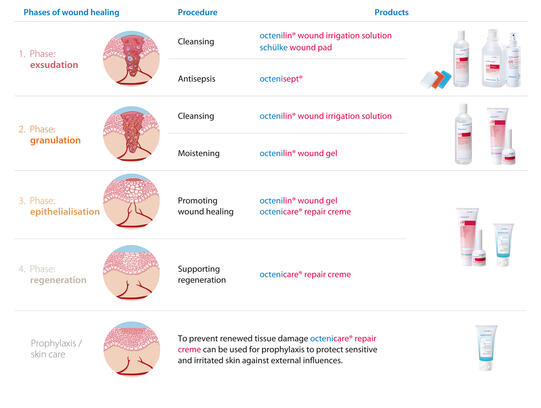
Pflichttexte zu zugelassenen Arzneimitteln gem. §4 HWG
octenisept®
octenisept®
Anwendungsgebiete:
zur wiederholten, zeitlich begrenzten antiseptischen Behandlung von Schleimhaut und angrenzender Haut vor diagnostischen und operativen Maßnahmen - im Ano-Genitalbereich von Vagina, Vulva, Glans penis, auch vor Katheterisierung der Harnblase - in der Mundhöhle. Zur zeitlich begrenzten unterstützenden Therapie bei Pilzerkrankungen der Haut zwischen den Zehen sowie zur unterstützenden antiseptischen Wundbehandlung.
Warnhinweise:
Um Gewebeschädigungen zu vermeiden, darf das Präparat nicht mittels Spritze in die Tiefe des Gewebes eingebracht werden. Das Präparat ist nur zur oberflächlichen Anwendung bestimmt (Auftragen mittels Tupfer oder Aufsprühen).
Zu Risiken und Nebenwirkungen lesen Sie die Packungsbeilage und fragen Sie Ihren Arzt oder Apotheker!
Traditional versus moist wound treatment
Traditionally, it was thought that wounds heal best when treated dry. The “exsiccation” of the wound and the formation of scabs were considered positive signs of wound healing. Nowadays, the disadvantages of the traditional wound treatment are evident. Firstly, the necessary cellular nourishment was interrupted, proliferation reduced and cell migration inhibited. In addition, the dressing changes were often traumatic due to the adhesion of the dressing material to the wound.
Meanwhile, a paradigm shift is taking place in wound treatment: Optimal wound treatment is carried out under moist conditions. Moist wound treatment creates ideal physiological conditions for wound healing: New cells can develop, proliferate and migrate more easily. Proper exudate management is also important in this context. The goal is to collect excess wound exudate while promoting an ideally moist wound environment. The dressing should ensure gas exchange and be capable of being replaced as atraumatically as possible.




















